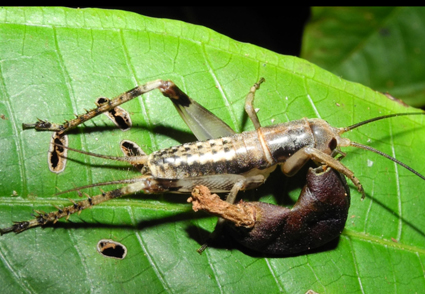Abstract
Neometrypus Desutter, 1988 n. status is elevated to the generic level. Ten new species of this genus are described (N. azevedoi n. sp., N. carvalhoi n. sp., N. catiae n. sp., N. couriae n. sp., N. lopesae n. sp., N. maiae n. sp., N. marcelae n. sp., N. mejdalanii n. sp., N. mendoncae n. sp., N. monnei n. sp.). All the species are from Brazil, nine from the Atlantic Forest, and one from Amazonia. We also provide a distribution map of all type localities of Neometrypus n. status, an identification key for all 13 known species of the genus, the first record of the mating behavior, and a short discussion about paedomorphic characters and communication between these crickets.
References
Adamo, S.A., Robert, D. & Hoy, R.R. (1995) Effects of a tachinid parasitoid, Ormia ochracea, on the behaviour and reproduction of its male and female field cricket hosts (Gryllus spp). Journal of Insect Physiology, 41, 269–277. https://doi.org/10.1016/0022-1910(94)00095-X
Alexander, R.D. & Otte, D. (1967) The Evolution of Genitalia and Mating Behavior in Crickets (Gryllidae) and other Orthoptera. Miscellaneous Publications, Museum of Zoology, University of Michigan. , Museum of Zoology, University of Michigan, Ann Arbor, Michigan, 62 pp.
Antonelli, A. & Sanmartín, I. (2011) Why are there so many plant species in the Neotropics? TAXON, 60 (2), 403–414. https://doi.org/10.1002/tax.602010
Antonelli, A., Zizka, A., Antunes, F., Scharn, R., Bacon, C.D., Silvestro, D. & Condamine, F.L. (2018) Amazonia is the primary source of Neotropical biodiversity. Proceedings of the National Academy of Sciences of the United States of America 115, 6034–6039. https://doi.org/10.1073/pnas.1713819115
Bell, P.D. (1980) Multimodal communication by the black-horned tree cricket, Oecanthus nigricornis (Walker) (Orthoptera Gryllidae). Canadian Journal of Zoology, 58, 1861–1868. https://doi.org/10.1139/z80-254
Burk, T. (1982) Evolutionary Significance of Predation on Sexually Signaling Males. The Florida Entomologist, 65, 90–104. https://doi.org/10.2307/3494148
Cadena-Castañeda, O.J., Soto, W.A.R., Cárdenas, A.D.P.F. & Acevedo, A. (2021) Studies on Neotropical crickets: The continental Otteiini taxa (Orthoptera: Phalangopsidae), those cave crickets are not confined to the West Indies. Zootaxa, 4981 (2), 331–356. https://doi.org/10.11646/zootaxa.4981.2.7
Campos, L.D. de & Desutter-Grandcolas, L. (2020) The Paroecanthini crickets (Orthoptera: Grylloidea: Gryllidae: Oecanthinae) from French Guiana. Zoosystema, 42, 355–398. https://doi.org/10.5252/zoosystema2020v42a20
Campos, L.D. de, Souza-Dias, P.G.B. de, Desutter-Grandcolas, L. & Nihei, S.S. (2021) Colonization of different biomes drove the diversification of the Neotropical Eidmanacris crickets (Insecta: Orthoptera: Grylloidea: Phalangopsidae). PLoS ONE 16, e0245325. https://doi.org/10.1371/journal.pone.0245325
Campos, L.D. de, Souza-Dias, P.G.B. & Nihei, S.S. (2020) New Brazilian Tafaliscina increase the diversity of this Neotropical cricket clade (Orthoptera: Grylloidea: Gryllidae: Oecanthinae: Paroecanthini). Zoosystema, 42, 331–353. https://doi.org/10.5252/zoosystema2020v42a19
Cigliano, M.M., Braun, H., Eades, D.C. & Otte, D. (2021) Orthoptera Species File. Version 5.0/5.0. WWW Document. Available from: http://orthoptera.speciesfile.org (accessed 20 September 2021)
Desutter, L. (1987) Structure et évolution du complexe phallique des Gryllidea (Orthoptères) et classification des genres Néotropicaux de Grylloidea. Primière Partie. Annales de La Société Entomologique de France, 23, 213–239.
Desutter-Grandcolas, L. (2003) Phylogeny and the evolution of acoustic communication in extant Ensifera (Insecta, Orthoptera). Zoologica Scripta, 32, 525–561. https://doi.org/10.1046/j.1463-6409.2003.00142.x
Dios, R.D.V.P. & Nihei, S.S. (2020) Taxonomic revision of the genus Trichopoda Berthold, 1827 (Diptera: Tachinidae: Phasiinae), with emphasis on the Neotropical fauna. Zootaxa, 4870 (1), 1–104. https://doi.org/10.11646/zootaxa.4870.1.1
Fianco, M. (2021) Nine new species of the Anaulacomerina subtribe of katydids (Orthoptera: Tettigoniidae: Phaneropterinae: Phaneropterini) from Brazil. Zootaxa, 4952 (1), 33–54. https://doi.org/10.11646/zootaxa.4952.1.2
Gorochov, A.V. (2017) Taxonomy of Podoscirtinae (Orthoptera: Gryllidae). Part 11: the tribe Hapithini and other American taxa. Zoosystematica Rossica, 26, 11–106. https://doi.org/10.31610/zsr/2017.26.1.11
Gwynne, D.T. (2001) Katydids and bush-crickets: reproductive behavior and evolution of the Tettigoniidae. Cornell University Press, Ithaca, New York, 371 pp.
Harrison, R.G. (1980) Dispersal Polymorphisms in Insects. Annual Review of Ecology and Systematics, 11, 95–118. https://doi.org/10.1146/annurev.es.11.110180.000523
Huber, F., Moore, T.E. & Loher, W. (1989) Cricket Behavior and Neurobiology. Cornell University Press, Ithaca, New York, 565 pp. https://doi.org/10.7591/9781501745904
Kathirithamby, J. (1989) Review of the Order Strepsiptera. Systematic Entomology, 14 (1), 41–92. https://doi.org/10.1111/j.1365-3113.1989.tb00265.x
Lehmann, G.U.C. & Heller, K.-G. (1998) Bushcricket song structure and predation by the acoustically orienting parasitoid fly Therobia leonidei (Diptera: Tachinidae: Ormiini). Behavioral Ecology and Sociobiology, 43, 239–245. https://doi.org/10.1007/s002650050488
Mcmahon, D.P. & Hayward, A. (2016) Why grow up? A perspective on insect strategies to avoid metamorphosis. Ecological Entomology, 41, 505–515. https://doi.org/10.1111/een.12313
Mesa, A. & Garcia-Novo, P. (2001) Neometrypus badius a new species of cricket with an unusual sex determining mechanism (Grylloidea, Eneopteridae, Tafaliscinae, Neometrypini). Journal of Orthoptera Research, 10, 81–87. https://doi.org/10.1665/1082-6467(2001)010[0081:NBANSO]2.0.CO;2
Morrone, J.J. (2014) Biogeographical regionalisation of the Neotropical region. Zootaxa, 3782 (1), 1–110. https://doi.org/10.11646/zootaxa.3782.1.1
Nalepa, C.A. & Bandi, C. (2000) Characterizing the Ancestors: Paedomorphosis and Termite Evolution. In: Abe, T., Bignell, D.E. & Higashi, M. (Eds.), Termites: Evolution, Sociality, Symbioses, Ecology. Springer Netherlands, Dordrecht, pp. 53–75. https://doi.org/10.1007/978-94-017-3223-9_3
Prado, R. (2006) Reproductive behavior of Eidmanacris corumbatai Garcia (Orthoptera: Phalangopsidae). Neotropical Entomology, 35, 452–457. https://doi.org/10.1590/S1519-566X2006000400005
QGIS Development Team (2021) QGIS Geographic Information System. Open Source Geospatial Foundation Project. Available from: https://qgis.org (accessed 12 October 2021)
Siewert, R.R., Mielke, O.H.H. & Casagrande, M.M. (2020) Taxonomic revision of the Neotropical genus Telemiades Hübner, [1819 (Lepidoptera: Hesperiidae: Eudaminae), with descriptions of fourteen new species. Zootaxa, 4721 (1), 1–111. https://doi.org/10.11646/zootaxa.4721.1.1
Stritih, N. (2014) Signaling by Protrusive Scent Glands in Cave Crickets, Troglophilus neglectus Krauss (Orthoptera: Rhaphidophoridae), is Primarily Involved in Male-male Agonism. Journal of Insect Behavior, 27, 317–332. https://doi.org/10.1007/s10905-013-9429-x
Su, Y.N. (2016) A simple and quick method of displaying liquid-preserved morphological structures for microphotography. Zootaxa, 4208 (6), 592–593. https://doi.org/10.11646/zootaxa.4208.6.6
Walker, T.J. & Masaki, S. (1989) Natural History. In: Cricket Behavior and Neurobiology. Cornell University Press, Ithanca, New York and London, 42 pp. https://doi.org/10.7591/9781501745904-003
Wong, A. (1996) A new species of neotenous beetle, Duliticola hoiseni (Insecta: Coleoptera: Cantharoidea: Lycidae) from Peninsular Malaysia and Singapore. Raffles Bulletin of Zoology, 44, 173–187.
Zuk, M., Rotenberry, J.T. & Tinghitella, R.M. (2006) s.n. Silent night : adaptive disappearance of a sexual signal in a parasitized population of field crickets, 2, 521–524. https://doi.org/10.1098/rsbl.2006.0539


